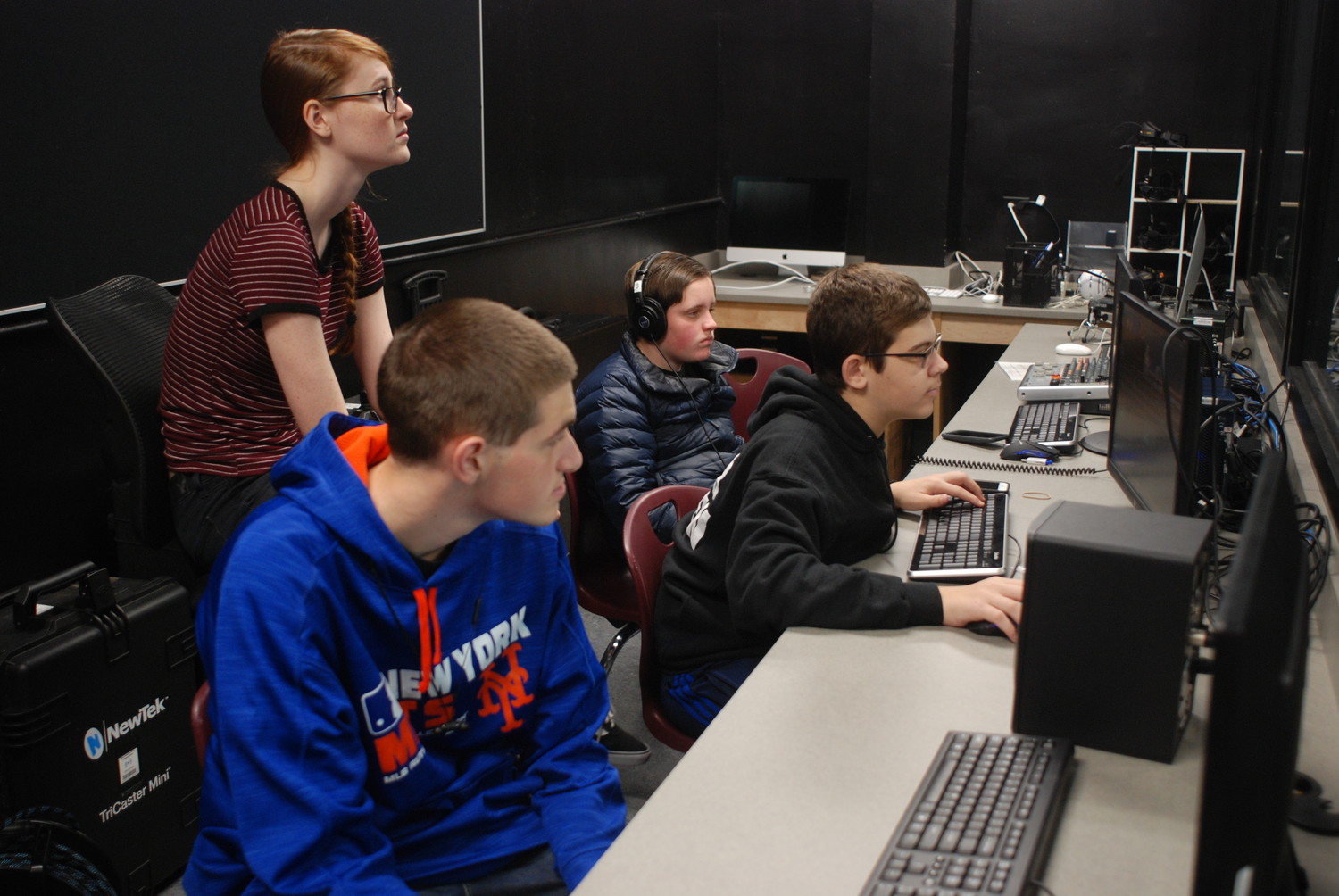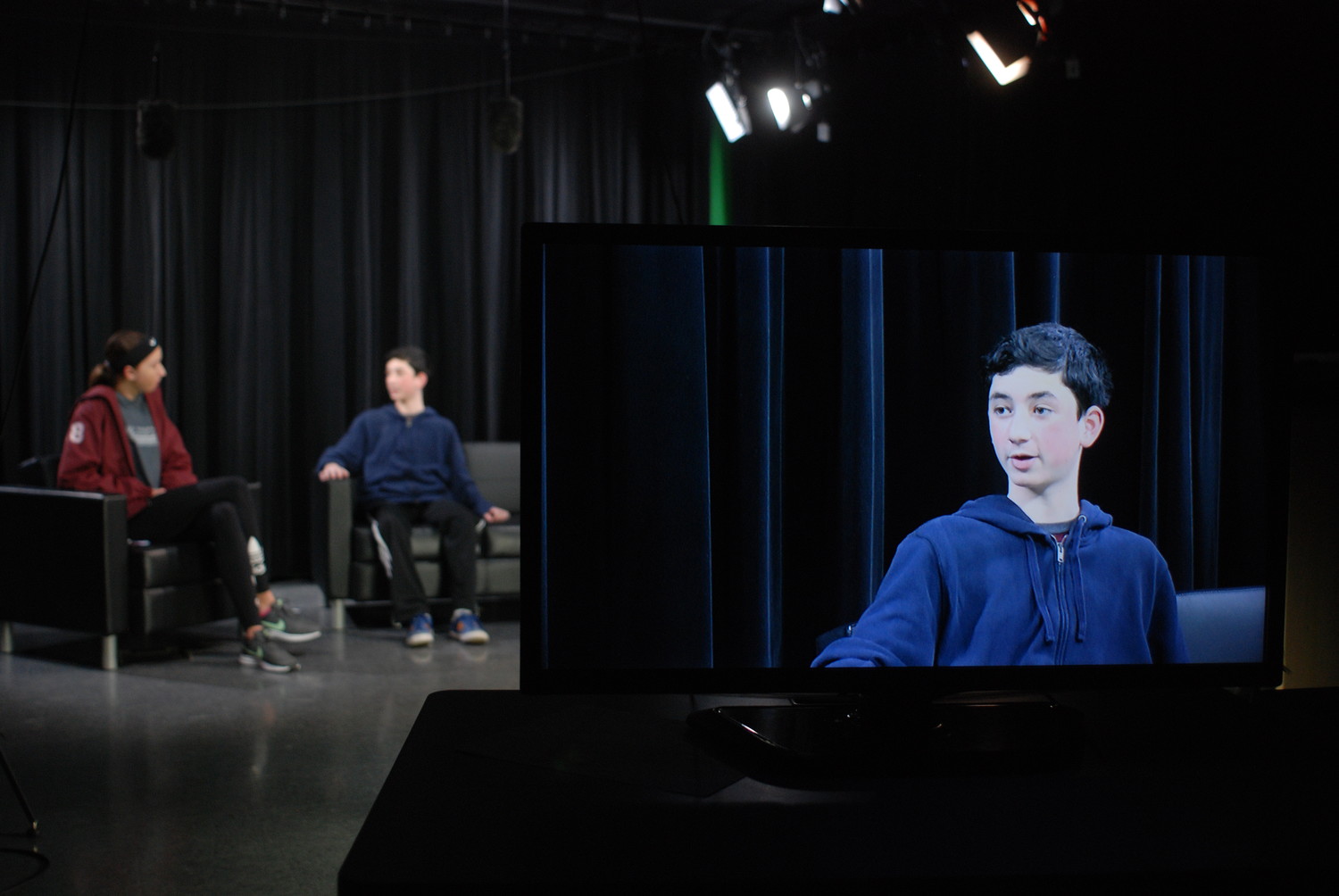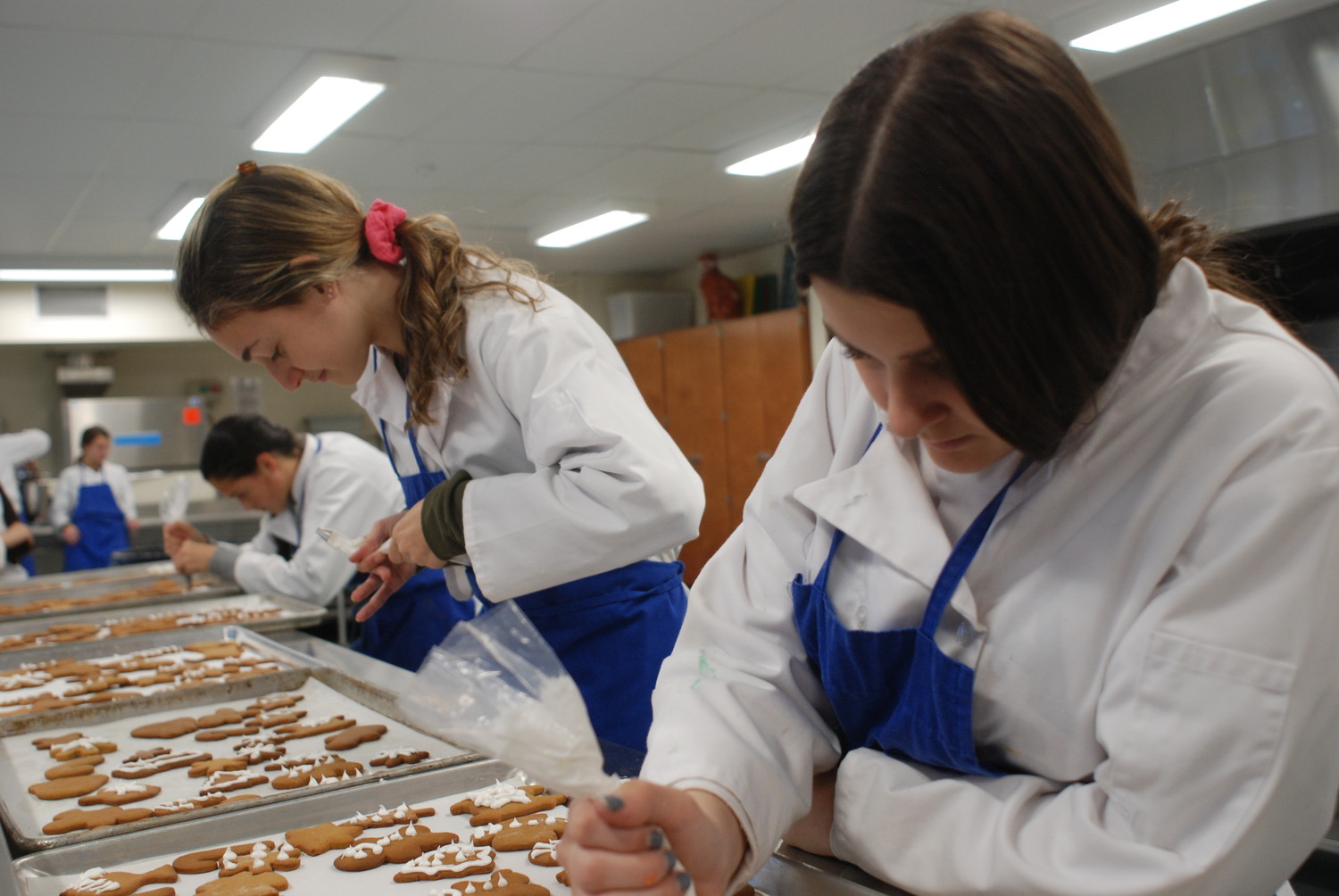Experiential learning, vocational education making a comeback
Learning by doing: what's old is new
Part five in the series “Educating the 21st Century Child.”
Mepham High School broadcast teacher Stu Stein often holds class in the dark, and with virtually every surface in his third-floor classroom painted black — every wall, every light switch, even the ceiling — it gets really dark when he does.
Such was the case on a recent Thursday morning, when Mepham Principal Eric Gomez sat on a comfortable-looking couch in a light pool in the center of Stein’s room, retelling his life story to 10th-grader Emma Greiner, who was interviewing him. Only Mr. Gomez wasn’t Mr. Gomez. He was played by 10th-grader Spencer Mattes, news director of BMBroadcasting, as the Bellmore-Merrick Central High School District’s broadcasting program is known.
Overhead stage lamps shone down on Emma and Spencer, who were running through lines in preparation for a big interview with the school principal the next morning. Meanwhile, their classmates stood in the shadows behind cameras and monitors and in the control room — yes, the control room — practicing their cues to ensure that all went as planned when Mr. Gomez arrived.
All of it had the look and feel of a professional newsroom.
That, educators say, is precisely the idea behind experiential learning — to create authentic experiences from which students can gain real-world experience. And experiential learning is becoming increasingly en vogue in Nassau County schools, despite an emphasis over the past decade on college-preparatory studies — that is, book learning.
In an experiential classroom, students still read and write — and read and write some more. But they also do, simulating situations that they might one day encounter in the workaday world as adults.
“I like the learning by doing,” said Spencer, 15, of Bellmore, who is manager of the Bellmore-Merrick Bulldogs hockey team and a member of the science and chess clubs. “You can’t look at a textbook and understand broadcasting.”
Experiential learning is growing in popularity not only on Long Island, but also across the country, even around the globe. On its website, Teaching and Learning for a Sustainable Future, the United Nations Educational Scientific and Cultural Organization states, “At the heart of all learning is the way we process our experiences, especially our critical reflections on our experiences . . . Experiential learning engages students in critical thinking, problem solving and decision making in contexts that are personally relevant to them.”
Spencer said he is weighing a possible career in sports broadcasting, but he’s uncertain. He also loves science and might go that route one day. Like most 10th-graders, he’s figuring it all out.
Beyond school walls
BMBroadcasting is a four-year magnet program that takes in students from throughout the Bellmore-Merrick Central School District, which includes Calhoun and Kennedy high schools in addition to Mepham. Many of the students are unsure whether broadcasting is for them, but that’s not the point, according to Stein. Through broadcasting, he said, they are learning a host of skills that they can apply to any college major or career that they might pursue.
Collaboration is key in the 21st century, both in school and in the workplace, educators say. According to Stein, there are few better ways to teach teamwork than broadcasting, which requires students to precisely time and coordinate their every word and action. At the same time, they learn communication skills by writing and editing scripts — and then acting them out in front of a camera. Shows are broadcast on BMBroadcasting’s YouTube Channel.
“The skills they’re gaining in the program are going to transcend the four walls of Mepham High School and help them to experience real-world problems and work toward a solution,” Mepham Assistant Principal Marie Netto said.
Funds to construct Mepham’s state-of-the-art broadcast studio came from a nearly $50 million bond that voters passed in December 2013. With the bond, the district also built a professional kitchen at Kennedy for its new Culinary Arts and Hospitality Program, which, like BMBroadcasting, is a magnet program that attracts students from throughout Bellmore-Merrick.
Vocational education redux
CAHP students in Merrie Ober’s cooking class stood around a long, rectangular table, intently decorating stacks of gingerbread cookies with white frosting on that recent Thursday. The cookies, which they had baked, would be donated to people in need, said Michael DiGiovanni, CAHP’s other cooking teacher, who helped found CAHP and is a high-end chef outside of school.
“We are not a home-ec class,” DiGiovanni said. CAHP, he noted, prepares students for possible careers in the culinary arts. “It’s a new trend,” he said, “making kids occupationally educated and teaching a vocational skill before college.”
He quickly added that students aren’t necessarily expected to go into culinary and hospitality management because they complete the four-year program. Unlike prior years, when cooking students were sent to the Board of Cooperative Educational Services for a majority of the day, Bellmore-Merrick’s culinary students remain at Kennedy, where they can follow any course of study they choose — Advanced Placement, Honors, Regents. Before, when they were sent to BOCES, their educational opportunities were limited because their academic classes, which they took at their home high schools for part of the day, were dictated by their BOCES schedules. When they completed BOCES, they were expected to enter the food-service industry.
Placing students in vocational programs, DiGiovanni also said, should help them to direct their studies once they reach college. In the past, many college students jumped from major to major, searching for their passion. They still do. Increasingly, however, students want to enter college ready to pursue a specific course of study so they can graduate on time — or early — and save money, in large part because college has become so costly. (Private universities now run as high as $60,000, $70,000, even $80,000 a year.)
Many culinary students, DiGiovanni said, come from long lines of chefs and bakers, many with restaurants and bakeries of their own, and the students want to carry on their families’ legacies. Take 11th-grader Renata Davi, 16, for example. Her father is a baker. So were her great-great-grandparents. Her great-grandfather was a chef. “With the taste of food,” she said, “you make people happy.”
Then there’s classmate Joceyln Cohn, 16, of Merrick. She cooked with her grandfather, who is passionate about food, as a child. In seventh grade, she took over the cooking at home. In the culinary arts program, she said, “I learned to make a really good cookie.” So she started her own online cookie company — Cohn’s Cookie Café — selling vegan, nut-free, kosher cookies.
Connecting the dots
Robert Soel is chairman of Kennedy’s Science Department. The Central District, he said, was among Nassau’s first to start Advanced Science Research and Engineering programs, with teachers dedicated to those disciplines, more than a decade ago.
The two programs, like the broadcast and culinary programs, are about connecting students with career options early and enabling them to see themselves in those fields in the future, Soel said. In this way, they can better decide which academic and career avenues they want to pursue — and which they do not.
“How do they place themselves in a role so they can feel it?” he said with a certain intensity in his voice. “How do they connect themselves to experiences so they can see themselves in that role? This is what robotics feels like. What does the role of an architect feel like?”
That, he said, is the essence of experiential learning.

 49.0°,
Fair
49.0°,
Fair 










